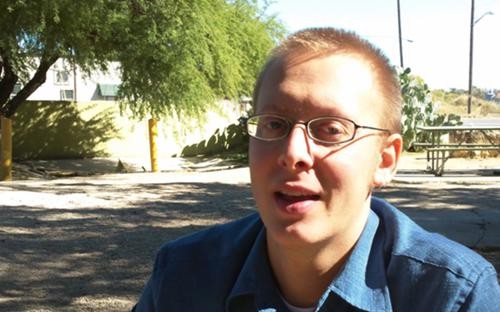In a city like San Antonio, with an enormous digital divide and serious disconnect between our community and potential resources, it’s a rough lot writing a tech column. With economic doom and gloom around every corner, discussion of media (both access and literacy), tends to fall flat in the face of the ever-present knowledge: resources just aren’t there. Where then do tech-savvy, glass-half-full gals like us turn for hope? To whom can we look for inspiration when trying to pull together a community around media and technology? This weekend, we got our answer from Sasha Costanza-Chock, a cheery, golden-haired media scholar, programmer, and community organizer from Los Angeles’ VozMob. VozMob, created by the Annenberg School for Communication & Journalism at the University of Southern California and the Institute of Popular Education of Southern California, addresses a whole package of typical communication and connectivity issues with readily available technology, an innovative open source platform, and participatory education. To break it down: established institutions, creative minds, and the very communities usually left out of really cool new tech all got together to make something useful and impactful. Best part? It’s literally as easy as sending a text. The setup requires a server, a little knowledge about hosting content, and a love of open source, collaborative software. Their site includes a wiki page documenting changes, challenges, and fixes for each version. You’ll find plug-ins and interesting additional bits of code as well as insights from their programmers all over the page — complete with tons of comments and feedback. [A bit about open source software: everything VozMob provides is free of charge — meaning everyone, regardless of financial resources can use the platforms they’ve created. The programmers only ask you provide any fixes, additional coding, and updates you create for free in turn, continuing the collaborative growth.] Once everything’s been set up, users set up accounts, record their data, and post content entirely through mobile devices. Yeah, you can log into the site and edit your content post-upload, but the most important parts involve tools available on even the cheapest pre-paid mobile phones. As a result, Los Angeleno day laborers, house workers, and immigrant communities (some of those most typically tech-less) now use SMS and MMS messaging to create a visible, permanent (once it’s online, it’s online) home for their stories via slideshows, blog posts, video and audio. If you stop and think about it, this is huge. From a demographic standpoint, VozMob managed to reach and actively engage a community without Internet access on the Internet. The entire project’s process came from intense collaboration. This yielded a product that’s both user-friendly and highly-functional, conquering one of the biggest challenges in whole-community technological involvement. When creating a product specifically aimed at those on the dark side of the digital divide, a focus on usability must be maintained. In order to do this, VozMob’s collaborators employed elements of popular education theory, asking users to answer the often-forgotten question: what do you need? Meeting with the intended community, analyzing the tech they already employ, and developing a SMS/MMS integrated web-based system took time, but the results were brilliant. An entire community without internet access suddenly had a web presence. What’s the point in learning all this cool stuff if we can’t do anything with it? OK, that’s a trick question. There is no point if the knowledge doesn’t get shared, used, and reused. The good news: VozMob’s open source platform truly is open source. Since their site lists everything needed to take their programming and apply it to any community, organization, or purpose, it’s application and reapplication is limitless. From extensive instruction to cut-and-paste coding, it’s all there. So, despite San Antonio’s current issues with journalism, community access, and visible storytelling, there’s hope. The saying goes, “everyone’s someone online.” With a simple, accessible way to publish untold stories, it takes little imagination to see the potential of giving voice to the voiceless. When you’re bored tonight surfing around the Internet looking up videos of goofy things, take a break from the cats playing with boxes, girl fights, and Twilight fan submissions to peek at VozMob’s collection of stories. Check out the interviews with people on the bus. Look up the slideshows of flower plantings created by gardeners. Learn what’s going on in the life of a Guatemalan housekeeper. It’s incredible what you can learn online. The Tech Tease, San Antonio residents and media justice activists DeAnne Cuellar and Rebecca Ohnemus, blog throughout the week at blogs.sacurrent.com. We welcome any and all questions, and feedback. We can be reached directly at [email protected]. You can follow Tech Tease on Twitter at@thetechtease.


















